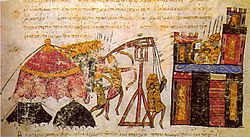Trebuchet
A Trebuchet was a device used in wars and sieges in the Middle Ages. It could be used to throw stones at ramparts, trying to break them down. It could also be used to throw things over the walls of a city. These could be corpses of animals or people that had died of the plague. Trebuchets were more accurate than other medieval catapults. Trebuchets were first made in China in the 4th century BC.
How it works
The trebuchet works in a simple way. The basket of the trebuchet is filled with heavy rocks. This acts as a counterweight for the other end, which is usually filled with one large rock. Several men arm the trebuchet by raising the counterweight up and the firing arm down. At this point the arm is released, the heavy basket swings down and the arm swings up, launching the rock far and fast. The sling adds an additional 10-15 feet of arm length and gives the projectile a whip like speed then releases. The sling gives the projectile most of its speed.
Trebuchet Media
Replica counterweight trebuchets at Château de Castelnaud
Counterweight trebuchet used in a siege from the Jami' al-tawarikh, c. 1306–1318[1][2]
The onager was a torsion powered weapon used in Europe from the 4th until the 6th century AD
Wheeled whirlwind traction trebuchet from the Wujing Zongyao[3]
Sicilian-Byzantine depiction of a traction trebuchet, 12th-13th century[4]
Siege of Naples (1191), c. 1196[5]
2012 demonstration of the Warwick Castle trebuchet (launch at 10:30)
Other websites
| Wikimedia Commons has media related to Lua error in Module:Commons_link at line 62: attempt to index field 'wikibase' (a nil value).. |
- Secrets of Lost Empires: Medieval Siege (building of and history of trebuchets), from the NOVA website
- article on Trebuchet Mechanics Archived 2009-03-05 at the Wayback Machine (in PDF format)
- The Finnish Trebuchet Archived 2007-03-11 at the Wayback Machine
- Homemade Trebuchet Archived 2007-04-09 at the Wayback Machine
- Homemade Spring Trebuchet Archived 2007-04-27 at the Wayback Machine
- Medieval Trébuchet Archived 2007-04-03 at the Wayback Machine
- Animated Trebuchet
- Evolution of Sling Weapons
- ↑ Fulton 2018, p. 425.
- ↑ Needham 1994, p. 236.
- ↑ Needham 1994, p. 2013.
- ↑ Fulton 2018, p. 420.
- ↑ Fulton 2018, p. 419.








